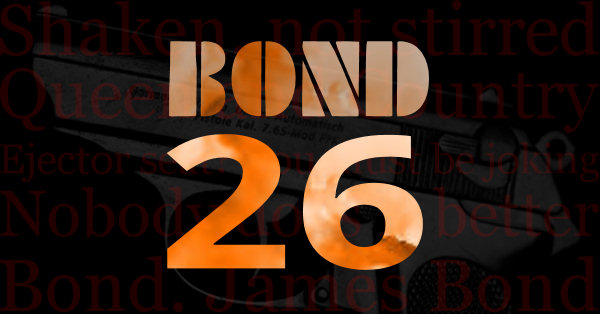
Reluctant as I am to admit it, Ian Fleming’s Bond novels were not terribly interesting when I first attempted to read them as an eleven year old. Fleming’s detailed verisimilitude – one of his key virtues when I returned to the books a few years later – and his interest in arcane research proved interminable. Patrick Nobes’s abridged versions were more accessible but those editions were in short supply.
Before Young Bond
Instead, the Bond book that really sparked my imagination at age twelve was The Adventures of James Bond Junior 003½ by the enigmatic R.D. Mascott (Jonathan Cape 1967). Mascott’s connections to Fleming’s work were tenuous. The protagonist was supposedly Bond’s nephew, with a similar resourcefulness and a knife given to him by his uncle. Yet that was sufficient for me to embrace the loose connection. I found the book more riveting than anything else I had read up to that time.
Afterward, I scoured the school library for something similar (without success). I also desperately tried to track down a copy, only to find it was long out of print. And once I left intermediate school, I had lost access to the copy in its library; it would be another two decades before I obtained one of my own.
By high school, of course, I was more interested in the John Gardner Bond novels and gained a greater appreciation for the Fleming originals, reading them all in sequence. Nevertheless, between ages ten and fourteen when I was obsessed with the films but still too young to fully appreciate Fleming, I certainly wished there had been some equivalent of the current Young Bond series to fill the gap.
Such books would not exist until 2005 when Charlie Higson’s Silverfin was published. (A little ironic for readers of my generation – in our early teens we could only read about Bond in his mid-thirties, then in our mid-thirties the only new Bond adventures being written were set when he was in his early teens.) And unlike Mascott’s earlier effort, Higson’s Young Bond series was actually about James Bond’s teenage years and are set in the 1930s during his time at Eton whereas The Adventures of James Bond Junior 003½ was a contemporary 1960s adventure featuring Bond’s supposed nephew as a surrogate figure for the reader. It was a book about a boy wanting to be like 007, a Don Quixote-like figure to appeal to readers wanting to be led astray by their own quixotic imagination, instead of a Bond story.
Mascott’s conceit, giving Bond a nephew, contradicts the back-story Fleming supplied in You Only Live Twice, where it is implied that Bond was an only child. At least no mention is made of any siblings, although John Pearson would later give Bond an older brother in James Bond: the Authorised Biography. Mascott even refers to the death of Bond’s father having occurred just three years before the story is set, even though we know from You Only Live Twice that Bond’s parents died in a climbing accident when he was eleven. 003½, then, represented an attempt to capitalise on the Bond brand, rather than an appendix to Fleming’s fictional universe.
The Young Bond novels
 Higson’s Silverfin and its four sequels, on the other hand, show meticulously researched continuity with the Fleming novels. As well as explaining the origins of Bond’s 4½ litre Bentley, Higson delves into the minutiae of Fleming. He shows us Bond discovering Pinaud Elixir shampoo – his favourite brand in later life – for the first time in Hurricane Gold, for instance. Connections to Fleming characters also provide ‘Easter eggs’ for astute readers. The Mighty Donovan, father of Red Grant from From Russia With Love appears in Silverfin, as does the father of Thunderball’s Count Lippe in Blood Fever; Bond encounters future friend Rene Mathis for the first time in ‘A Hard Man to Kill’ (the short story included in Danger Society). Higson even makes clever use of unpublished Fleming material – such as in By Royal Command including the character of Graf Schlick from a story a young Ian Fleming used to recount during his time in Kitzbuhel, Austria, or using the character name Manny the Girl from Fleming’s notebooks for a henchman in Hurricane Gold.
Higson’s Silverfin and its four sequels, on the other hand, show meticulously researched continuity with the Fleming novels. As well as explaining the origins of Bond’s 4½ litre Bentley, Higson delves into the minutiae of Fleming. He shows us Bond discovering Pinaud Elixir shampoo – his favourite brand in later life – for the first time in Hurricane Gold, for instance. Connections to Fleming characters also provide ‘Easter eggs’ for astute readers. The Mighty Donovan, father of Red Grant from From Russia With Love appears in Silverfin, as does the father of Thunderball’s Count Lippe in Blood Fever; Bond encounters future friend Rene Mathis for the first time in ‘A Hard Man to Kill’ (the short story included in Danger Society). Higson even makes clever use of unpublished Fleming material – such as in By Royal Command including the character of Graf Schlick from a story a young Ian Fleming used to recount during his time in Kitzbuhel, Austria, or using the character name Manny the Girl from Fleming’s notebooks for a henchman in Hurricane Gold.
Delving into Bond’s past does requires a lot of extrapolation from the fragments of information scattered throughout the Fleming novels, however. This is a difficult task to execute without appearing apocryphal. Fleming biographer John Pearson had previously attempted it in his fictional James Bond: the Authorised Biography (Sidgwick & Jackson, 1973). Pearson’s get-out-of-jail-free card is that he was supposedly giving us the biographical facts of the ‘real’ James Bond, whereas Fleming’s Bond was supposedly the imposter (building on an idea suggested by Fleming himself in You Only Live Twice – that the real Bond had become the subject of a series of popular book “written about him by a personal friend of former colleague of James Bond.” i.e Ian Fleming.) But the result was that the Bond of Pearson’s fictional biography, like the protagonist of The Adventures of James Bond Junior reads like something of a literary counterfeit.
Higson’s Young Bond books are more convincing, mainly because he was presenting new episodes from Bond’s past dramatically, as stories from earlier in the fictional timeline of the Fleming novels. (For this same reason we can accept Skyfall Lodge as Bond’s family home in the movie Skyfall – the filmmakers’ extrapolation on Fleming’s choice of Glencoe for Bond’s ancestral seat in OHMSS – as part of the cinematic-Bond canon, whereas when Pearson describes an almost identical “stone house in the Highlands which was still the centre of the family”, it feels simply like a Pearson invention. Because he doesn’t integrate it into a fictional narrative, as part of a Bond adventure.)
There is a paradox here. Skyfall and Higson’s Young Bond books are more far-fetched than Pearson’s fictional biography. Mascott’s book was also more realistic story than Silverfin, more tonally similar to Fleming. Yet the reader is more willing to suspend disbelief in Skyfall or Silverfin and accept that they are getting an authentic glimpse into Bond’s past. If the action doesn’t contradict the wider timeline of the movie or literary Bond canon, audiences will accept it. (This is also why the use of the Aston Martin from Goldfinger in Skyfall, on the other hand, did not work. Because in the rebooted timeline established in 2006’s Casino Royale, Daniel Craig’s Bond is not the same guy from the 1960s movies.)
The fact does remain, however, that although belonging to the same fictional timeline as the Fleming novels, the very idea of Bond battling a series of super-villains in his early teens, in the short space of a couple of terms at Eton with very little breathing time between each adventure, is absurd. Especially when young James is menaced by such fantastical science fiction plot devices as mutated eels in Silverfin. In From Russia With Love Bond doubts whether his seventeen year old mountaineering self would recognise his adult self if he came up to him in the street and talked to him. (“And what would that youth think of him, the secret agent, the older James Bond?”) The question is would the adult Bond recognise the Bond of the Higson novels? The answer: unlikely.
A more realistic portrayal of Bond’s early years, in keeping with Fleming would be too uneventful to hold likely commercial appeal. The carefree ‘bucket and spade’ existence alluded to in On Her Majesty’s Secret Service, cut short by the tragic death of his parents not long after, doesn’t provide much grist for kids’ books. At best, even his climbing and skiing adventurers as a teen would hold more potential as William Wordsworth-like ‘Spots of Time’ rather than confrontations with criminal masterminds. To appeal to a young readership raised on Harry Potter, to give them a substitute for the adult Bond novels, it was necessary for Higson to take liberties and make the stories more fantastical.
For adult Bond fans, enjoyment of Higson’s Young Bond is dependent upon ignoring the improbability the underlying conceit of fourteen year old Bond as a hero (not something likely to bother his target demographic). They need to be considered, instead, as well written stories in their own right; the same as the John Gardner James Bond continuation novels are best enjoyed in their own right rather than in direct comparison to Fleming.
As kids’ adventure stories, Higson’s Young Bond books skilfully blended the vibrant imagination of Roald Dahl with the narrative drive of vintage John Buchan. Also, Higson’s prose is excellent, giving his books the bespoke craftsmanship of a Saville Row suit or an Aston Martin. A tough act to follow. Nevertheless, Steve Cole has now stepped into Higson’s shoes, taking up the mantle of Young Bond author and delivering Shoot To Kill.
Shoot To Kill
 John Cox, in his review of Shoot To Kill, likened Higson to Fleming and Steve Cole to John Gardner resurrecting the literary Bond in the 1980s. A more accurate parallel would be to see Higson as John Gardner and Cole as Raymond Benson picking up the reins after Gardner retired in the mid-nineties. Benson lacked Gardner’s fluency as a writer but he did have a better understanding of Bond as a character and a greater ability to create new original Bondian storylines. Likewise, Steve Cole lacks Higson’s command of syntax and descriptive focus but he compensates through superior plotting and by avoiding the more fantastical science fiction elements of his predecessor.
John Cox, in his review of Shoot To Kill, likened Higson to Fleming and Steve Cole to John Gardner resurrecting the literary Bond in the 1980s. A more accurate parallel would be to see Higson as John Gardner and Cole as Raymond Benson picking up the reins after Gardner retired in the mid-nineties. Benson lacked Gardner’s fluency as a writer but he did have a better understanding of Bond as a character and a greater ability to create new original Bondian storylines. Likewise, Steve Cole lacks Higson’s command of syntax and descriptive focus but he compensates through superior plotting and by avoiding the more fantastical science fiction elements of his predecessor.
I’m not suggesting that Charlie Higson’s plots were weak per se, just that as much as I enjoyed all five of his Young Bond adventures, the plots were not particularly memorable. I’m struggling to recall them, just as I struggle to remember more than superficial details of most of the John Gardner novels, whereas the set-pieces of the Raymond Benson stories are more vivid in my memory, just as the Fleming originals were. And Steve Cole conjures up similar memorable set-pieces in Shoot To Kill.
The different strengths and weakness of the two Young Bond authors aside, Steve Cole picks up directly where Charlie Higson left off at the end of By Royal Command. Bond has now been expelled from Eton and is due to attend Fettes in Scotland in accordance with the back-story from Fleming. This transition provides the ideal place for a new author to take up the mantle. The five Higson novels loosely parallel the first five Ian Fleming novels. Dr No, Fleming’s sixth novel, represented something of a rebirth for Bond, following the cliff-hanger ending of From Russia With Love where readers are uncertain whether Bond has died as a result of being kicked by Rosa Klebb’s poison-tipped shoe. He returns to active duty after several months recovering and is sent off to Jamaica on his first new mission – with a new gun, his now famous Walther PPK.
Shoot To Kill is also something of a rebirth for Bond, about to start a new school, with a new author at the helm. Except the school is not the anticipated Fettes. Instead, Cole gives Bond a short stint at the progressive, coeducational Dartington Hall School in Devon (Ann Fleming’s friend the artist Lucian Freud, whose portrait of Ann hung in Ian Fleming’s London drawing-room and who stayed with the Fleming’s at Goldeneye, was an ex-pupil in real life).
At first, this embellishment to the canon, sending Bond to a different school not mentioned in Fleming, is a little jarring. But it works well in context and doesn’t necessarily contradict Fleming, merely shakes the reader’s sense of equilibrium. As a plot device, this works well. Any reader uneasiness at Bond briefly attending a school so at odds with our assumptions about his education at more conservative British public schools provides pay off in terms of creating a sense of menace, given that the villain is researching experimental education methods. Plus sending Bond to a co-ed school allows Cole to provide a better gender balance in terms of characterisation, giving Bond female peers (girls who defy gender stereotypes to boot).
The other important thematic concern in Shoot To Kill apart from education is cinema. Dr No was, of course, the first Fleming novel filmed and in homage to this milestone, Steve Cole uses the movie world as a backdrop for Shoot To Kill, with 1930s Los Angeles and a Hollywood studio as the setting for the second half of the novel. And within the story, Cole also pays tribute to the fact that, as for most of us, the cinema was where he first encountered Bond. Seeing A View To A Kill in 1985 was what inspired him to read Ian Fleming.
Shoot To Kill’s airships reflect the lingering impact that particular movie had on his adolescent imagination and could be interpreted as an effort to counter his possible youthful consternation or disappointment at the lack of similarity between the film and the short story ‘From a View to a Kill’. He has written the book he had wanted to read as a fourteen year old in the wake of A View To A Kill. The trans-Atlantic flight aboard Anton Kostler’s gigantic airship, the Allworld, is clearly inspired by the similar giant airship on which Zorin holds his in-flight board-meeting en route to California in A View To A Kill, while Shoot To Kill’s climax takes place on a smaller airship, identical to the climax of A View To A Kill.
If Bond’s journey on the Allworld – with glamorous representatives of the movie world, as well as more dubious fellow passengers – also recalls the glittering climax aboard an airship from Sapper’s 1926 Bulldog Drummond thriller The Final Count, it is worth remembering that the Bulldog Drummond books were a major influence on Fleming. (Higson’s Bond is reading a Bulldog Drummond novel in Silverfin, too.)
Carl Peterson, the recurring Drummond villain who meets his comeuppance about the airship in The Final Count, provided direct inspiration for Ernst Stavro Blofeld. The scenes aboard the Allworld in Shoot To Kill recall the sinister atmosphere of Blofeld’s Piz Gloria allergy clinic, where menace lurks beneath the benign surface – with Kostler keeping the passengers under surveillance, bugging their conversations for his own nefarious reasons.
The airship sequence helps give Anton Kostler a presence throughout the first half of the novel, even though – like Dr No – we don’t meet him until later in the novel, and helps enhance our sense of him as a villain. Overall, Cole’s characterisation is rudimentary, however. Tori Wo, the lead female character, for example, is rather one-dimensional figure – much like the endless stock female secret agents inserted into the Bond movies in lieu of the idiosyncratic originality of Fleming characters such as Tiffany Case, Honeychile Rider or Tracy. As an investigative journalist, she has little purpose aside from providing an adult counterpart to Bond’s investigation to nudge the exposition forward.
Cole’s minor villains are similarly stock Gangster figures with little attempt to make them memorable. But he delineates Bond’s school chums with more skill. He deliberately avoids stereotypes. The school bully is female. The dwarf, Hugo, is courageous and sympathetic – a welcome change from Fleming making anybody who doesn’t fit the accepted norms of physical perfection or beauty into villains. Boudicca Pryce (Boody), similarly, reveals that she is more than a pretty face, repairing the airgun obtains after a clash with a thug early on in the story, in a nice homage to Boothroyd, the secret service armourer, providing Bond with the iconic Walther PPK in Dr No.
In keeping with Higson’s tradition of including characters from the Fleming canon, Jack Strap, a gangster from Goldfinger, makes a cameo. Also, we can infer that aspiring screenwriter Stuart Sloman’s stage-play Bitter Pearl will ultimately become the Hollywood movie Kissy Suzuki supposedly starred in six years before the events of You Only Live Twice. (How many movies about Ama divers from Japan’s Kuro Island in one fictional universe can there be?)
Again these connections to Fleming help reinforce that events are taking place in the same timeline, even if – like with the previous Young Bond adventures – the conceit is highly fanciful. Shoot To Kill might not be as outlandish as Silverfin but it is still highly fantastical in terms of a schoolboy having such adventures. (What teacher would really turn a blind eye to Bond stealing an ambulance in order to make an airship flight, for instance?)
Though I doubt teenage readers care about such things. For them such absurdities probably represent the equivalent wish-fulfilment older readers get from the fantasy of luxury and danger in Fleming. And Steve Cole is a superb storyteller. The pacing rarely slackens as he takes us through a series of set-pieces, including the flight on the Allworld to a shootout in a movie set of a Wild West town.
It is just a shame that he is often too focused on keeping the story moving at breakneck speed to notice minor editorial lapses (on page 278, the Zelda is a ‘helium’ airship; a few pages later it is ‘hydrogen’) or that he lacks Charlie Higson’s prose style. But then, to paraphrase the mighty Raymond Chandler, the combination of qualities that can blend expert style and plotting are seldom found in the same mind. As Chandler said of crime writers, “The fellow who can write you a vivid and colourful prose simply won’t be bothered with the coolie labour of breaking down unbreakable alibis.”
While there are no detective story unbreakable alibis to break down, Shoot To Kill still demonstrates Cole’s willingness to undertake such ‘coolie labour’ and deliver an exciting narrative. I look forward to his future Young Bond instalments.
Craig Arthur lives in Dunedin, New Zealand, where he is currently working on a spy novel. His articles as a guest writer have previously graced the main pages of MI6-HQ.com and Commanderbond.net.
Craig Arthur ©2014
Click here to order ‘Shoot To Kill’ from Amazon UK










